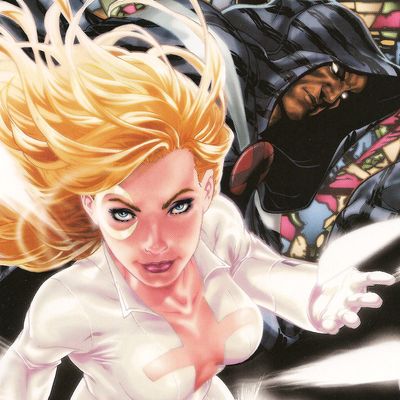
As the march toward Peak Superhero continues, genre giants Disney and Warner Bros. are being forced to dig deeper and deeper in the back-issue bin of Marvel and DC Comics, respectively, in search of characters to adapt. Properties like Iron Fist and the Suicide Squad were hardly known outside the comics-geek world before their filmed versions were announced — and even within that world, they weren’t A-listers. But one of the most obscure adaptations yet was announced last week: Marvel’s Cloak and Dagger. We know precious little about it, other than that it’s based on two characters from Marvel, it’ll feature teen romance, and it’s been ordered straight to series by Freeform, the network formerly known as ABC Family. Mainstream audiences are unlikely to have any idea who these titular folks are. Indeed, even Marvel nerds would be hard-pressed to give you much information about them beyond some extremely basic contours: They’re young, they’re a couple, Cloak’s an African-American man who can teleport people, and Dagger’s a white woman who can shoot daggers made of light. That’s about it. Everything else is up for grabs. Therein lies the show’s potential strength.
Marvel has an opportunity here to tell a filmed story without needing to appeal to any kind of rabid fanbase or honor any iconic stories, because the characters have neither. They first appeared in a Spider-Man comic in 1982, the brainchildren of writer Bill Mantlo and artist Ed Harrigan. Mantlo established that Cloak and Dagger — a.k.a. Ty Johnson and Tandy Bowen, respectively — were teen runaways who became unwitting victims of a sinister experiment that gave them their powers. I got this information exclusively from secondary sources, because their debut comic isn’t available in Marvel’s digital store, on the Netflix-esque Marvel Unlimited service, or in the Amazon-owned digital-comics retailer comiXology.com. There are no greatest-hits collections of stories about Cloak and Dagger, either. All of that should tell you something. Marvel doesn’t really see the characters’ existing stories as that important to the fabric of the Marvel mythos.
That doesn’t mean the characters are total non-entities in Marvel history, of course, or that Marvel thinks of them as embarrassments (NFL SuperPro they’re not). They’ve appeared in hundreds of comics over the decades, many of them quite good, and a few dozen of which straight-up starred the duo. They don’t pop up all that often anymore, but they just had a multiple-issue arc in The Amazing Spider-Man a few months back. This upcoming show may be airing on a low-profile cable network in the process of rebranding itself, but higher-ups like Marvel Entertainment chief creative officer Joe Quesada and Marvel TV chief Jeph Loeb clearly think there’s some gold in them thar super-hills. However — and this is a subjective assessment — it’s pretty safe to say no Cloak and Dagger stories have really stuck in the geek imagination.
Given that fact, they could stand alone as comparatively blank pages for filmed superhero output without fear of angering (mostly nonexistent) diehards. The Avengers-connected movies are filled with world-famous characters and steeped in classic story lines. Same goes for Marvel’s Daredevil, the upcoming Marvel’s Luke Cage and Marvel’s Iron Fist, the X-Men movie franchise, and nearly every DC Comics–based movie and show. Marvel’s Agents of S.H.I.E.L.D. and Marvel’s Agent Carter feature characters with little-to-no existing mythology, but they’re not really superhero tales so much as sci-fi-tinged espionage sagas. Guardians of the Galaxy dealt with lesser-known Marvel characters, but similarly was more of a space opera than a superhero yarn. The closest analogue is Marvel’s Jessica Jones, which followed a character who was largely unknown outside hardcore comics-geek circles — but even there, the creators tied themselves to Jessica’s best-known comic-book adventure, in which she went up against the mind-controlling rapist Kilgrave.
Cloak and Dagger could follow Jessica Jones’s lead and pluck some story from the duo’s publication history. But I suspect that virtually no one would complain if they made something from whole cloth. They don’t have any famous archnemeses that fans would be clamoring to see (except, I guess, maybe the terribly named D-lister D’Spayre, who was once revealed to be part of their origin story? But I challenge you to find 10 D’Spayre fanboys/-girls in the world). They don’t have a widely read graphic novel that people would demand a version of. We don’t even know if the show will be set in the Marvel Cinematic Universe, so we might finally have a Marvel Studios property that doesn’t rely on winks and crossovers for thrills and chills.
Instead, Cloak and Dagger could be something unique and potentially lovely: an attempt to build a new bit of filmed superhero iconography (mostly) from the ground up. There’s so much to mine in this genre. It deals metaphorically with the burdens, risks, and liberations of power — and it has the storytelling freedoms offered by high-concept science fiction, fantasy, and magical realism. Cinema and TV are still a long, long way away from the kind of explosion of brand-new superhero ideas that the world saw in comics back in the early 1940s and the early 1960s. But any tiny steps away from strict adaptation and toward true invention are good steps to take.




